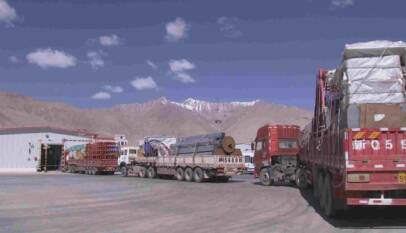CPEC envisages Digital Revolution in Pakistan
Pakistan is set to walk right into a digital future as Chinese Investment and commitment to revitalise Pakistan’s digital infrastructure increases. 820 kilometer long fibre optic project over expanse of Gilgit Baltistan, Mansehra and Muzaffarabad in the Northern region and 6299 kilometers of underwater cable extending from Gwadar to Djibouti connects Pakistan to digital silk road encompassing China and other BRI countries in Africa. It will facilitate flow of information through e-commerce, e-payments, electronic customs clearing procedures thereby contributing to seamless International trade. Coupled with BeiDou’s satellite navigation system, Huawei’s 5G network will soon reinvigorate Pakistan’s IT space helping it become a viable link in the BRI and global supply chain.
The 820-kilometer-long fibre optic cable project at a cost of $46 million, stretches from China’s western Xinjiang region and enters Pakistan through Khunjerab border and then travels through Gilgit Baltistan (GB) to Mansehra, KP to connect to Muzaffarabad, AJK and onwards to Islamabad and Rawalpindi, where it is connected with the existing optical connectivity network of Pakistan.
In order to optimise existing and future coordination in the supply chain within Pakistan and with the Chinese, digital connectivity would help the flow of information, financial transactions and physical goods and services. It will also promote and facilitate regional economic cooperation and will enable many ICT integration services between both countries. This connectivity spread from many soft to hard infrastructural projects such as paperless trade facilitation, e-commerce, e-government, playing a supporting role in the construction and management of industrial parks, roads, rail, aviation and ports. On the other hand, this cable connectivity will provide many opportunities to enhance people-to-people connectivity between China and Pakistan. The adaptation of China’s Digital Terrestrial Multimedia Broadcasting (DTMB) technology is an indispensable component for socio cultural collaboration. The arrival of the DTMB standard in Pakistan enables high definition (HD) broadcasting for digital television (TV) which will provide many opportunities for the Pakistani media industry for revenue generation and promote many cultural exchange programmes at a higher resolution between China and Pakistan.
CPEC fibre optics play a vital role for unimpeded trade through the China-Pakistan border. The digital infrastructural deficit in GB is one of the biggest hurdles for efficient cross-border trade facilitation between China and Pakistan through the Khunjerab border. The inception of a new fibre cable introduced the online WEBOC (Web Based One System) custom system at the dry port in GB, which is the first customs dry port through which all cargo coming from Khunjerab border must get cleared by Pakistan Customs before entering the country. It is recommended to have proper training for using this new system and address the queries of local traders before introducing new WEBOC at Sust port and further integrate this new system with the Chinese customs system. This will help reduce leakages in shipped goods and delay due to cumbersome documentation procedures of the old system and reduce the trade facilitation problems persisting at the China-Pakistan border.
Laying the 820-kilometer-long China-Pakistan fibre optic cable between the city of Rawalpindi, Pakistan in the south and the Khunjerab Pass, China in the north, has been operational since July, 2018.
By 2020, 6,299 kilometres of underwater cables will extend to Djibouti from Gwadar and form the Digital Silk Route between Asia and Africa. At the same time, a space-based Silk Road will provide satellite navigation support to all BRI countries. The first Beidou base station of the Space Silk Road is already operational in Pakistan since 2017. BeiDou is making rapid progress with 30 BRI countries already linked up.
When completed, the ambitious global initiative would use an exclusive satellite navigation system; BeiDou, fibre networks and 5G on land and submarine cables will create a multi-dimensional digital mega-project across land, sea and space.
Huawei is already pushing for 5G deployment in Pakistan where it has already established a strong market presence. The Pakistan Telecom Authority (PTA) has already identified spectrum in the 2.6 GHz, 3.5 GHz and millimetre wave band it plans to allocate for auction to 5G vendors. This will include both fixed and mobile 5G deployment. PTA has set up a 5G working group with members from telecom operators, vendors, manufacturers, academia, research and development organisations, regulator (PTA), government ministries and the Frequency Allocation Board (FAB).
Over 65 million Pakistanis now subscribe to 3G and 4G services launched 5 years ago. 5G uptake rate in Pakistan is expected to be rapid. Attractive tariffs for 5G users will be the key to encouraging a large number of customers. The Trump Administration sees China’s aggressive 5G lead as a threat to the West’s technology dominance. The US government has been warning its allies against using Huawei’s 5G equipment in their networks based on its fears of Chinese government espionage operations.
Chinese 5G suppliers currently hold 36 percent of all 5G patents worldwide. In spite of US efforts, Chinese telecom giants Huawei and ZTE are beating their western rivals to acquire access to huge markets around the world in Asia, Africa, South America and the Middle East.
China is aggressively pursuing its plans to build a global digital superhighway that runs through Pakistan. This “Digital Silk Road” involves laying fibre optic cables in Pakistan which connect with China to the north and link with Africa and the Arab World via undersea cable to be laid from Gwadar Deep Sea Port built as part of China-Pakistan Economic Corridor (CPEC).
The global project will include 5G wireless networks deployment in the Belt-Road Initiative (BRI) member nations. Meanwhile, the United States is continuing its campaign to have its allies boycott 5G equipment built by China’s Huawei. However, for Pakistan the digital divide that exists with the West will be bridged through BRI systems incorporating communication and connectivity which will allow for manifold transfer of technology and a greater opportunity for our technological ecosystem to develop and flourish.
Experts say Pakistan needs stable policies to fully utilize China’s expertise in clean energy and industrial development
Pakistan’s energy sector investments are on a complex trajectory. Despite government effor…









